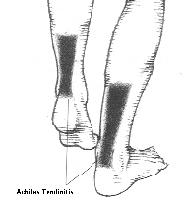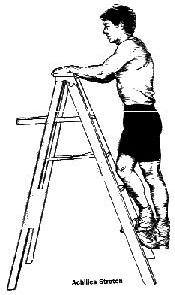Achilles Tendinitis
This troublesome heel pain is caused by inflammation of the Achilles tendon. The Achilles is the large tendon connecting the two major calf muscles–the gastrocnemius and soleus–to the back of the heel bone. Under too much stress, the tendon tightens and is forced to work too hard. This causes it to become inflamed (that’s tendinitis) and, over time, can produce a covering of scar tissue that is less flexible than the tendon. If the inflamed Achilles continues to be stressed, it can tear or rupture.
 Symptoms: Dull or sharp pain anywhere along the back off the tendon, but usually close to the heel. Limited ankle flexibility. Redness or heat over painful area. A nodule (a lumpy buildup of scar tissue) that can be felt on the tendon. A crackling sound (scar tissue rubbing against the tendon) when the ankle moves.
Symptoms: Dull or sharp pain anywhere along the back off the tendon, but usually close to the heel. Limited ankle flexibility. Redness or heat over painful area. A nodule (a lumpy buildup of scar tissue) that can be felt on the tendon. A crackling sound (scar tissue rubbing against the tendon) when the ankle moves.
Causes: Tight or fatigued calf muscles, which transfer too much of the burden on running to the Achilles. This can be brought on by not stretching the calves properly, increasing mileage too quickly, or simply overtraining. Excessive hill running or speedwork, both of which stress the Achilles more than other types of running, can also cause tendinitis Inflexible running shoes, which force the Achilles to twist, cause some cases. Runners who overpronate (their feet rotate too far inward on impact) are susceptible to Achilles tendinitis.
Self-treatment: Stop running. Take aspirin or ibuprofen and ice the area for 15 to 20 minutes several times a day until the inflammation subsides.
Self-massage may also help. “I have every therapeutic machine available for the treatment of Achilles tendinitis, and the treatment of choice is massage with a heat-inducing cream or oil,” says Marc Chasnov, a physical therapist in Rye Brook, New York. he suggests rubbing semicircles in all directions away from the knotted tissue three times a day.
 Once the nodule is gone, stretch the calf muscles. Don’t start running again until you can do toe raises without pain. next, move on to skipping rope, then jumping jacks, and then gradually begin running again. You should be back to easy running in six to eight weeks.
Once the nodule is gone, stretch the calf muscles. Don’t start running again until you can do toe raises without pain. next, move on to skipping rope, then jumping jacks, and then gradually begin running again. You should be back to easy running in six to eight weeks.
Medical treatment: If your injury does not respond to self-treatment in two weeks, see a physical therapist or orthopedic surgeon. Surgery to scrape scar tissue off the tendon is a last resort and not very effective. “It usually just stimulates more scar tissue,” says Chasnov.
Alternative exercises: Cycling in a low gear, swimming, and pool running. No weight-bearing exercises.
Preventive measures: The best stretch for the Achilles tendon is also the simplest. Stand on the balls of your feet on stairs, a curb, or a low rung of a ladder, with your legs straight. Crop both of your heels down and hold for a count of 10. To increase the intensity of the stretch, keep one foot flat and lower the other heel. When done, switch legs.
SOURCE: Burffot, Anby, ed. Runners World Complete Book of Running. Rodale Press Inc., 1997.
